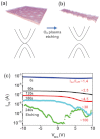Tunable transport gap in narrow bilayer graphene nanoribbons
- PMID: 23409239
- PMCID: PMC3570781
- DOI: 10.1038/srep01248
Tunable transport gap in narrow bilayer graphene nanoribbons
Abstract
The lack of a bandgap makes bulk graphene unsuitable for room temperature transistors with a sufficient on/off current ratio. Lateral constriction of charge carriers in graphene nanostructures or vertical inversion symmetry breaking in bilayer graphene are two potential strategies to mitigate this challenge, but each alone is insufficient to consistently achieve a large enough on/off ratio (e.g. > 1000) for typical logic applications. Herein we report the combination of lateral carrier constriction and vertical inversion symmetry breaking in bilayer graphene nanoribbons (GNRs) to tune their transport gaps and improve the on/off ratio. Our studies demonstrate that the on/off current ratio of bilayer GNRs can be systematically increased upon applying a vertical electric field, to achieve a largest on/off current ratio over 3000 at room temperature.
Figures




Similar articles
-
High on/off ratios in bilayer graphene field effect transistors realized by surface dopants.Nano Lett. 2011 Jul 13;11(7):2640-3. doi: 10.1021/nl200631m. Epub 2011 Jun 20. Nano Lett. 2011. PMID: 21688768
-
Toward tunable band gap and tunable dirac point in bilayer graphene with molecular doping.Nano Lett. 2011 Nov 9;11(11):4759-63. doi: 10.1021/nl2025739. Epub 2011 Oct 10. Nano Lett. 2011. PMID: 21985035 Free PMC article.
-
Magnetic response of conductance peak structure in junction-confined graphene nanoribbons.Nanoscale. 2012 Feb 21;4(4):1138-45. doi: 10.1039/c1nr11056j. Epub 2011 Nov 14. Nanoscale. 2012. PMID: 22080960
-
Graphene nanoribbons: A promising nanomaterial for biomedical applications.J Control Release. 2020 Sep 10;325:141-162. doi: 10.1016/j.jconrel.2020.06.034. Epub 2020 Jul 2. J Control Release. 2020. PMID: 32622962 Review.
-
New routes to graphene, graphene oxide and their related applications.Adv Mater. 2012 Sep 18;24(36):4924-55. doi: 10.1002/adma.201202321. Epub 2012 Aug 20. Adv Mater. 2012. PMID: 22903803 Review.
Cited by
-
A carbon nanotube-graphene nanoribbon seamless junction transistor.Nanoscale Adv. 2020 Jan 30;2(2):659-663. doi: 10.1039/c9na00797k. eCollection 2020 Feb 18. Nanoscale Adv. 2020. PMID: 36133223 Free PMC article.
-
Dirac cone move and bandgap on/off switching of graphene superlattice.Sci Rep. 2016 Jan 6;6:18869. doi: 10.1038/srep18869. Sci Rep. 2016. PMID: 26732904 Free PMC article.
-
Photocurrent generation in lateral graphene p-n junction created by electron-beam irradiation.Sci Rep. 2015 Jul 8;5:12014. doi: 10.1038/srep12014. Sci Rep. 2015. PMID: 26152225 Free PMC article.
-
Synthesis of quasi-free-standing bilayer graphene nanoribbons on SiC surfaces.Nat Commun. 2015 Jul 9;6:7632. doi: 10.1038/ncomms8632. Nat Commun. 2015. PMID: 26158645 Free PMC article.
References
-
- Novoselov K. S. et al. Electric field effect in atomically thin carbon films. Science 306, 666–669 (2004). - PubMed
-
- Novoselov K. S. et al. Two-dimensional gas of massless Dirac fermions in graphene. Nature 438, 197–200 (2005). - PubMed
-
- Dean C. R. et al. Boron nitride substrates for high-quality graphene electronics. Nat. Nanotechnol 5, 722–726 (2010). - PubMed
-
- Wu Y. Q. et al. High-frequency, scaled graphene transistors on diamond-like carbon. Nature 472, 74–78 (2011). - PubMed
Publication types
MeSH terms
Substances
LinkOut - more resources
Full Text Sources
Other Literature Sources
Molecular Biology Databases
Miscellaneous

